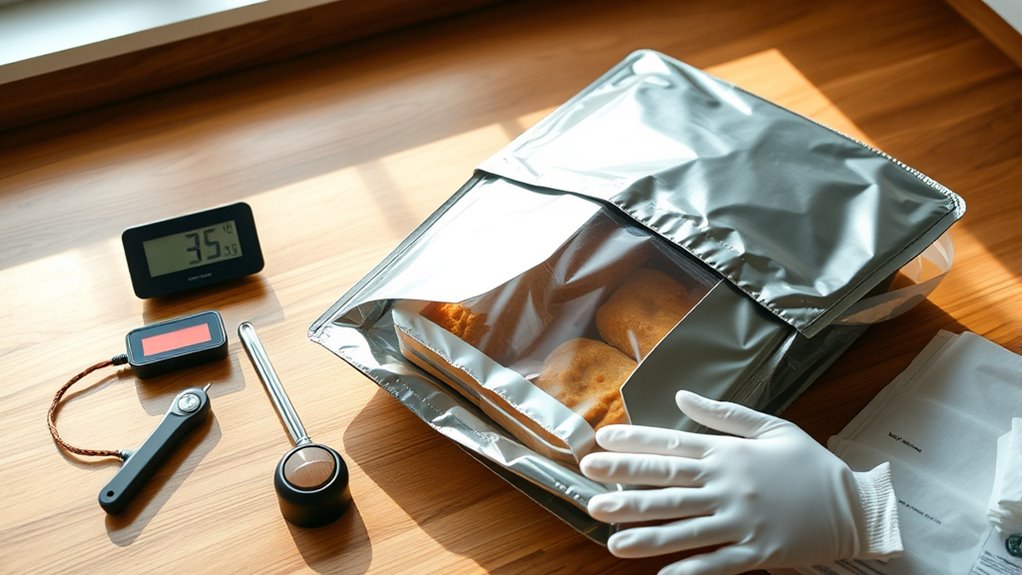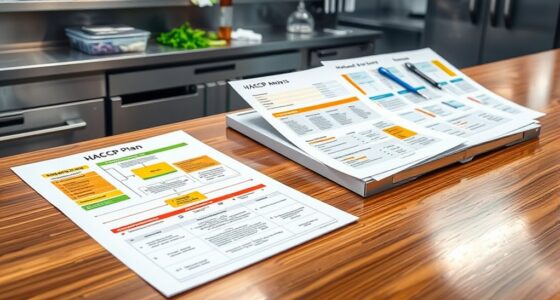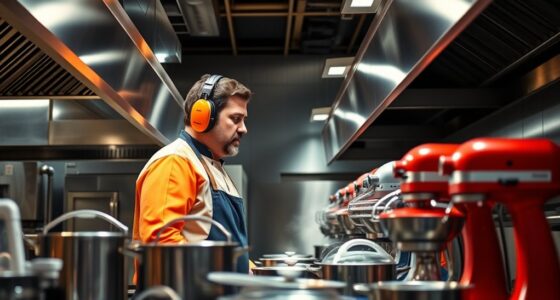To guarantee third-party delivery food safety, you should implement strict handling protocols, including thorough hygiene practices, secure leak-proof packaging, and clear labeling. Keep hot foods above 140°F and cold below 40°F using insulated containers and real-time temperature monitoring. Train delivery staff on safety procedures, maintain clean equipment, and conduct regular audits to catch key issues early. Continuing will reveal essential tips to strengthen your safety controls and protect your customers.
Key Takeaways
- Implement regular staff training on hygiene, packaging, and temperature control protocols for third-party delivery personnel.
- Use tamper-evident, sturdy packaging with clear labeling to prevent contamination during transit.
- Employ real-time temperature monitoring devices and alerts to ensure food remains within safe temperature ranges.
- Conduct frequent audits of delivery processes, packaging, and temperature logs to verify compliance and identify risks.
- Maintain detailed documentation of training, inspections, and corrective actions to ensure accountability and traceability.
Implementing Strict Food Handling Protocols
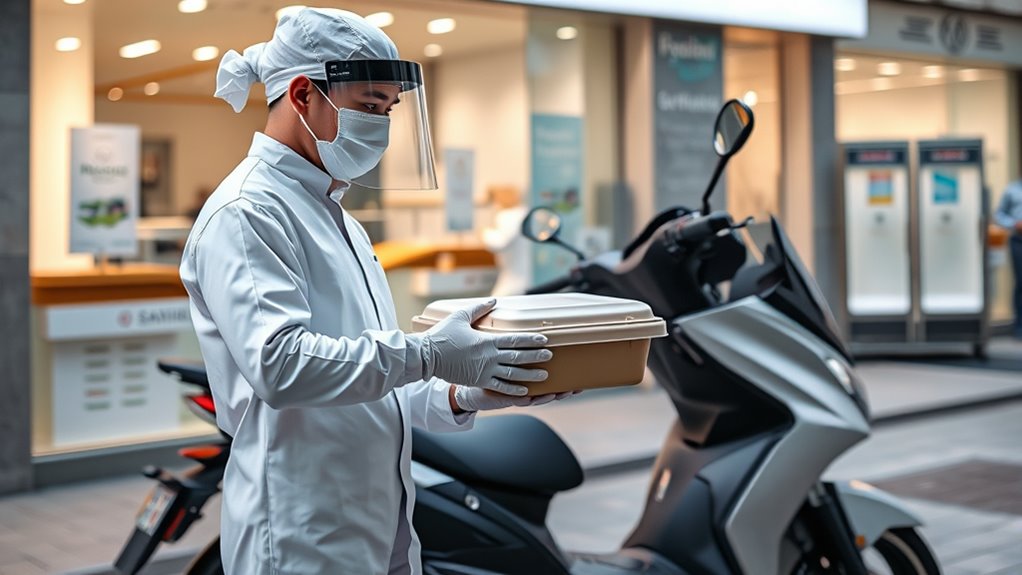
Implementing strict food handling protocols is essential to guarantee the safety of delivered food. You need to train all staff involved in preparing, packing, and delivering food on proper hygiene practices. This includes frequent handwashing, wearing clean gloves, and using sanitized utensils and containers. Avoid cross-contamination by separating raw and cooked foods and cleaning surfaces regularly. Establish clear procedures for storing food at appropriate conditions and handling leftovers safely. Consistent adherence to these protocols minimizes the risk of foodborne illnesses. You should also enforce personal hygiene standards, such as health checks for staff and proper attire. Proper food injection cleaning is crucial in maintaining the integrity of stored ingredients and preventing bacterial contamination. By maintaining rigorous handling practices, you ensure that every meal reaches customers safely and meets quality standards.
Ensuring Proper Temperature Control During Transit
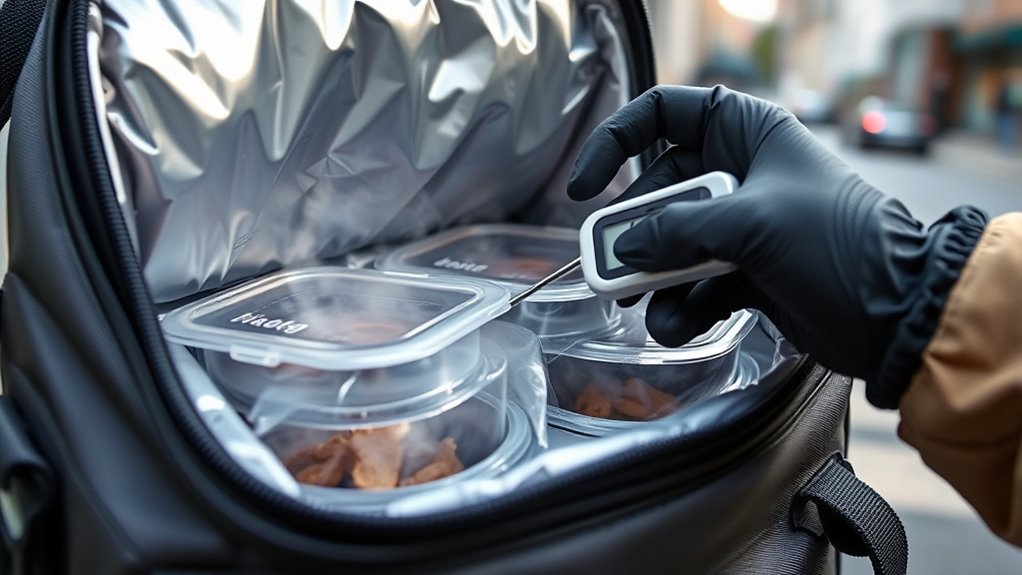
Maintaining proper temperature control during transit is crucial to preserve food safety and quality. You should ensure hot foods stay above 140°F (60°C) and cold foods stay below 40°F (4°C) throughout delivery. Use insulated containers and temperature-sensitive packaging to prevent heat transfer. Regularly verify that delivery vehicles are equipped with functioning temperature monitoring devices. If a delivery exceeds safe temperature ranges, you must have procedures to address the situation, such as discarding compromised food or re-cooling hot items promptly. Clear communication with delivery personnel about the importance of maintaining temperatures is essential. Proper temperature control reduces the risk of bacterial growth and foodborne illnesses, protecting your customers and your reputation. Consistent monitoring and appropriate packaging are key to successful transit temperature management. Additionally, implementing regulated temperature controls can further ensure compliance with safety standards and enhance overall food safety during delivery.
Training Delivery Personnel on Food Safety Practices
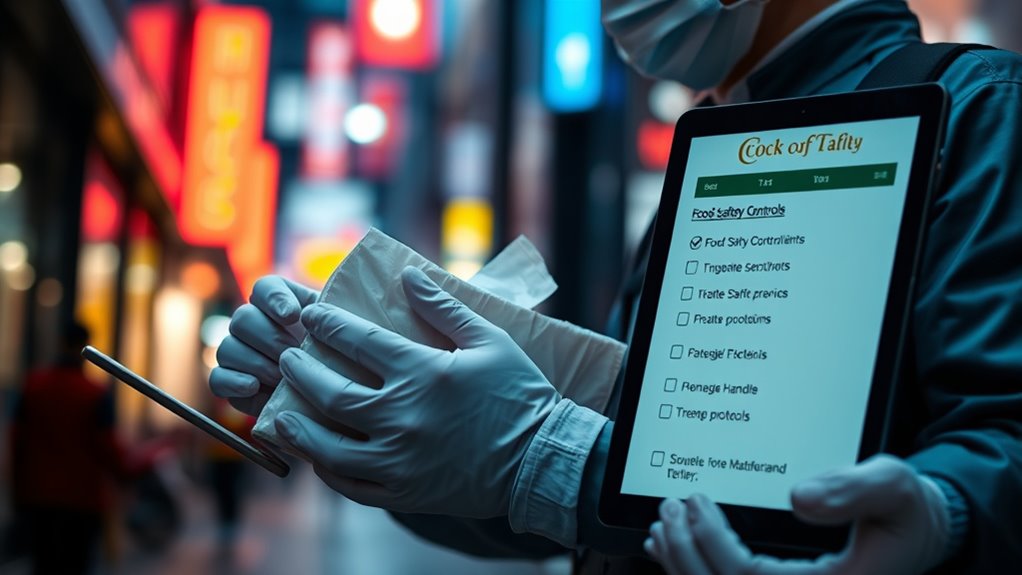
Proper training of delivery personnel is essential to ensuring food safety practices are consistently followed during transit. Well-trained drivers understand the importance of handling food properly, maintaining temperature, and preventing cross-contamination. Your training should cover key topics like safe handling procedures, hygiene standards, and recognizing signs of spoilage. Reinforcing these principles helps reduce risks and build accountability. Consider including practical, scenario-based instruction to prepare delivery personnel for real-world challenges. Regular refreshers ensure adherence to protocols and keep safety top of mind. Clear communication, ongoing education, and accountability measures are critical to maintaining high standards. By investing in all-encompassing training, you empower delivery personnel to uphold food safety and protect customer health. Incorporating industry trends into training programs helps keep staff updated on the latest best practices.
Utilizing Secure Packaging to Prevent Contamination
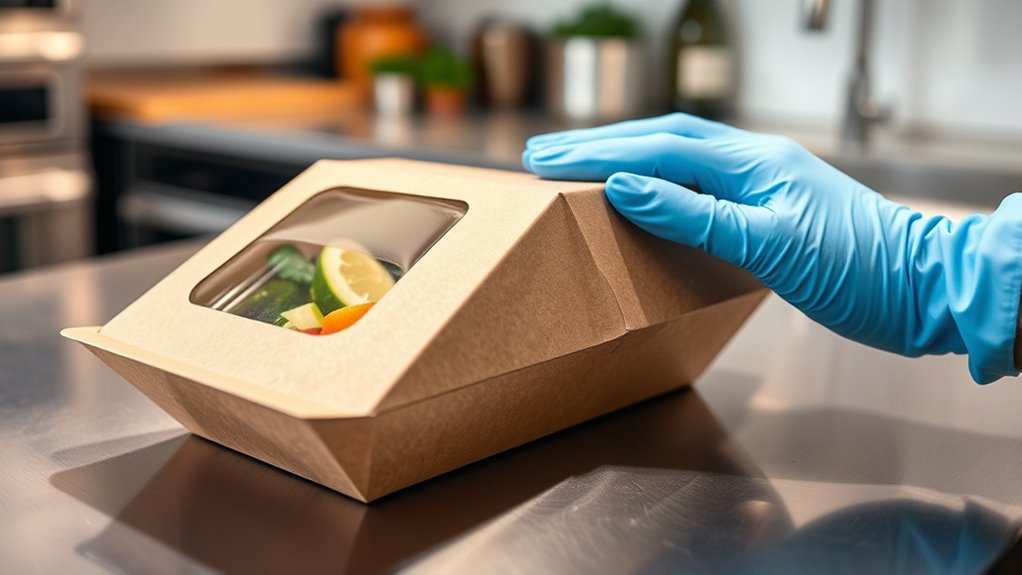
Using secure packaging is essential to preventing contamination during food delivery. It keeps food protected from dirt, germs, and physical damage as it moves from the restaurant to the customer. Choose packaging materials that are sturdy, leak-proof, and resistant to tampering. Use sealed containers, especially for liquids or sauces, to prevent spills and exposure to airborne contaminants. Separate raw items from cooked foods with appropriate barriers to avoid cross-contact. Label packages clearly to indicate hot, cold, or allergen-containing foods, reducing the risk of mishandling. Consider using tamper-evident seals to alert customers if the package has been opened. Proper packaging not only maintains food quality but also reassures customers that their meals are safe and hygienic upon arrival. Additionally, understanding food safety principles helps ensure that packaging methods meet health standards and protect consumer well-being.
Establishing Real-Time Food Monitoring Systems
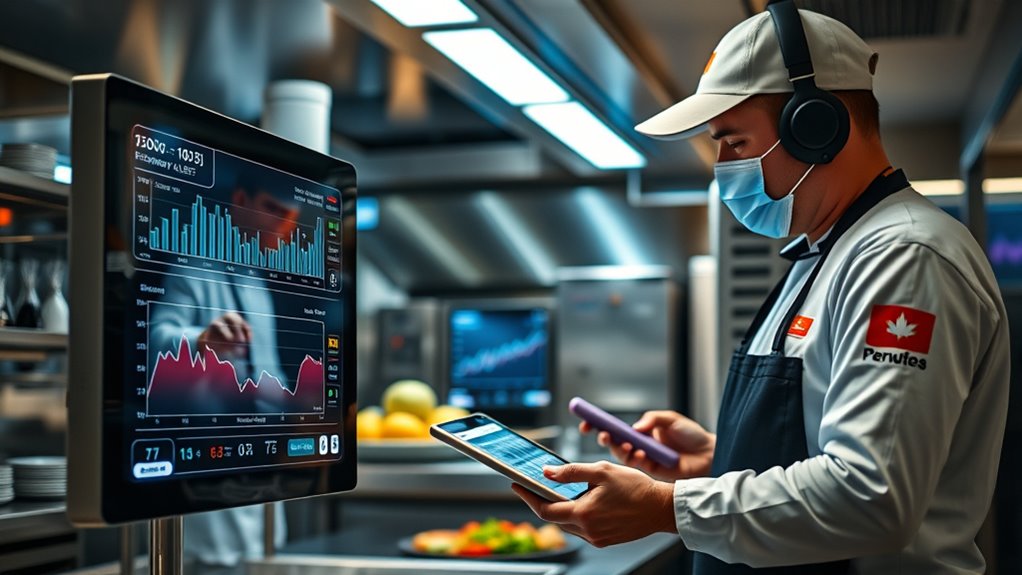
How can real-time food monitoring enhance safety during delivery? It allows you to track temperature, humidity, and location continuously, ensuring food remains safe throughout transit. Immediate alerts notify you of any deviations, reducing the risk of contamination or spoilage. This proactive approach helps you address issues before they compromise safety or quality. Implementing such systems also improves accountability, providing transparency for customers and stakeholders. You can integrate sensors and IoT devices to automate monitoring, minimizing human error. Regular data collection enables trend analysis and process improvements. Additionally, real-time monitoring builds customer trust by demonstrating your commitment to safety contrast ratio.
Maintaining Clean and Sanitized Delivery Equipment
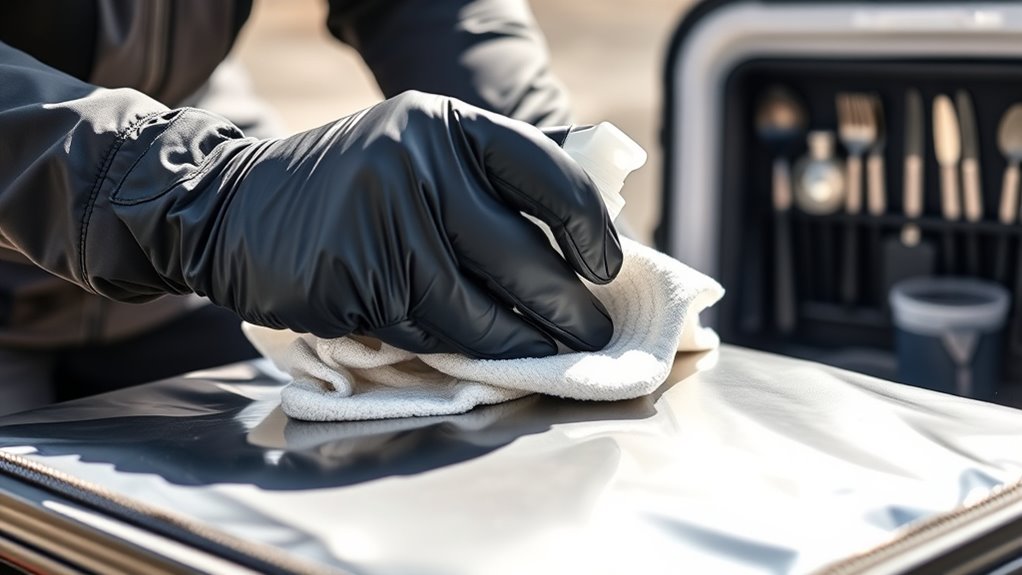
Maintaining clean and sanitized delivery equipment is essential to prevent cross-contamination and guarantee food safety. You should regularly clean delivery bags, containers, and utensils after each use, following manufacturer guidelines. Use appropriate disinfectants to eliminate germs and bacteria that could transfer onto food. Pay special attention to handles, zippers, and seams, where dirt and residue can hide. Ensure your cleaning routines include washing with hot water and soap, then sanitizing with approved solutions. Dry equipment thoroughly before reuse to prevent mold growth. Incorporating proper sanitation procedures into your routine helps reduce the risk of bacteria buildup. Consistent cleaning not only protects customers but also extends the lifespan of your delivery tools. Incorporate a strict cleaning schedule into your daily routine and train staff to follow proper sanitation procedures diligently. This proactive approach helps maintain a safe, hygienic delivery process.
Developing Clear Communication Channels for Food Safety Alerts
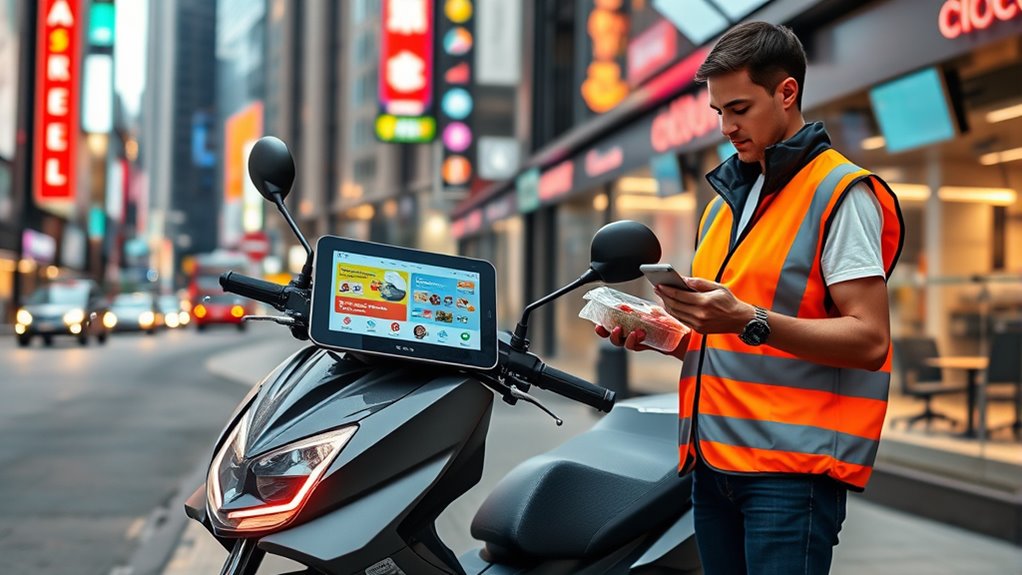
Effective communication channels are essential for promptly sharing food safety alerts and preventing potential contamination issues. When a food safety concern arises, swift, clear communication guarantees that all parties respond effectively, minimizing risk to consumers. To develop these channels, consider establishing multiple methods of contact, such as email, SMS alerts, dedicated apps, and phone hotlines. Ensure messages are concise, actionable, and contain critical details like the nature of the risk, affected items, and recommended steps. Regularly test these systems for reliability and clarity. Additionally, define escalation procedures for urgent alerts and assign specific roles for communication. Clear documentation of protocols helps maintain consistency and accountability across all delivery partners. Using multiple communication methods enhances overall response efficiency and ensures everyone is informed and ready to act swiftly when food safety issues occur.
Conducting Regular Audits and Compliance Checks
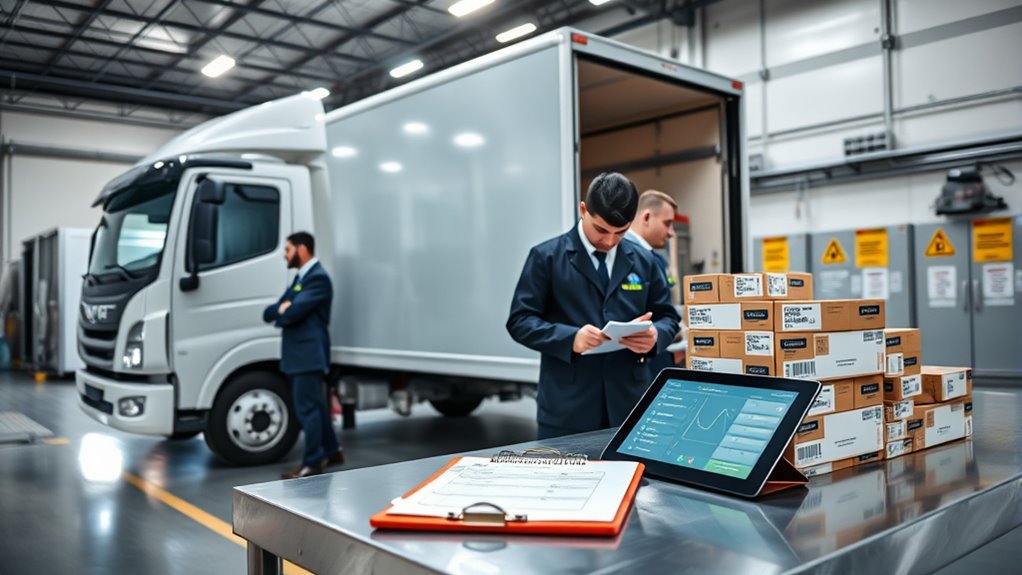
Regular audits help guarantee your delivery processes stay compliant and safe. You need to set appropriate frequency and scope to catch issues early. Keeping detailed compliance records also makes it easier to verify standards and improve your food safety practices. Incorporating personality assessment tools can further enhance staff training and team dynamics, leading to more reliable service.
Audit Frequency and Scope
Conducting frequent audits and compliance checks is essential to guarantee third-party delivery services meet food safety standards. Regular assessments help identify potential risks, ensure adherence to protocols, and maintain quality. The scope of these audits should be exhaustive, covering areas like packaging, temperature control, hygiene, and staff training. The frequency of audits depends on factors such as the delivery volume, past compliance, and regulatory requirements. High-risk operations may require weekly or bi-weekly reviews, while lower-risk services can be assessed monthly. Establishing clear criteria for scope and timing ensures consistency and accountability. Properly scheduled audits foster continuous improvement and mitigate food safety hazards before they escalate. Including proper documentation during audits ensures traceability and accountability for all inspections conducted.
Compliance Documentation and Records
How do you guarantee that third-party delivery services consistently meet food safety standards? The key is maintaining thorough compliance documentation and records. You should require delivery partners to keep detailed logs of safety training, equipment maintenance, and temperature checks. Regularly review these records to verify adherence to safety protocols. Implement a system for tracking audit results, corrective actions, and follow-up inspections. By documenting every step, you create an audit trail that demonstrates compliance and highlights areas for improvement. This proactive approach helps you identify potential risks before they escalate. Ensuring records are accurate, complete, and up-to-date allows you to hold third-party services accountable, maintain high safety standards, and quickly address any issues that arise. Additionally, establishing clear vendor reliability criteria during onboarding can further enhance your oversight.
Frequently Asked Questions
How Do Third-Party Apps Verify Restaurant Food Safety Standards?
To verify restaurant food safety standards, third-party apps typically require restaurants to submit health inspection reports and certifications. They may also conduct their own audits or inspections. When you order through these apps, they monitor restaurant hygiene practices, review customer feedback, and sometimes use third-party inspectors to guarantee safety protocols are adhered to. This helps you feel more confident that your food arrives safe and hygienic.
What Liability Does a Delivery Platform Hold for Contaminated Food?
While it’s tempting to believe delivery platforms are solely responsible, they often hold limited liability for contaminated food. You should know that their role mainly involves facilitating connections and ensuring secure transactions. If food arrives spoiled or unsafe, liability varies by jurisdiction and circumstances. Usually, the restaurant bears primary responsibility, but platforms might be involved if they negligently failed to enforce food safety standards or overlooked serious complaints.
Are There Legal Requirements for Third-Party Delivery Food Safety Audits?
You might wonder if legal rules require third-party delivery services to conduct food safety audits. While specific laws vary by location, many jurisdictions don’t have strict mandates for mandatory audits. Instead, they often rely on existing food safety regulations that restaurants and vendors must follow. Delivery platforms typically have their own standards, but legally, you’re safer when they adhere to local health codes and enforce proper food handling practices.
How Is Customer Feedback Used to Improve Food Safety Controls?
Did you know that 85% of customers say their feedback influences restaurant improvements? When you share your experience, you help identify safety issues or quality concerns. Your feedback prompts restaurants to review their procedures, train staff better, or improve hygiene standards. This ongoing communication creates safer dining experiences and builds trust. So, your comments aren’t just opinions—they’re essential tools for enhancing food safety controls for everyone.
What Technologies Are Emerging to Enhance Delivery Food Safety Monitoring?
You’re curious about emerging technologies that improve delivery food safety monitoring. You’ll find that real-time GPS tracking helps you monitor delivery routes, ensuring food stays at safe temperatures. Smart sensors on packaging detect temperature changes and contamination risks, alerting you instantly. AI-powered analytics predict potential safety issues before they happen, giving you peace of mind. These innovations help you enjoy safe, high-quality food delivered directly to your door.
Conclusion
By prioritizing strict food safety controls, you protect your customers and build trust. When you implement proper handling, temperature, and sanitation protocols, you’re not just avoiding contamination—you’re ensuring quality. It’s tempting to focus on speed, but without these safeguards, quick delivery means little if food safety is compromised. Remember, in food delivery, haste can overshadow safety. Balancing efficiency with rigorous safety measures is what truly guarantees satisfied, healthy customers.
